Top 12 Automated Code Review Tools for 2025
In modern software development, manual code reviews are a significant bottleneck. They consume valuable engineering hours, introduce human error, and slow down release cycles. The solution is clear: integrating automated code review tools into your workflow is no longer a luxury but a fundamental requirement for maintaining velocity, security, and quality. These tools act as a first line of defense, catching bugs, security vulnerabilities, and style inconsistencies long before they reach a human reviewer or, worse, production.
This guide eliminates the guesswork by providing a comprehensive roundup of the best automated code review tools available today. Whether you're a developer seeking instant feedback in your IDE, an engineering manager aiming to enforce standards, or a DevSecOps professional focused on shifting security left, you'll find a solution tailored to your specific needs. While automated code review streamlines early detection, a holistic approach to software quality also involves understanding comprehensive quality assurance practices and test case planning processes.
We'll dive deep into each tool, analyzing core features, ideal use cases, pricing, and integration capabilities. You’ll get an honest look at their strengths and weaknesses, complete with screenshots and direct links to help you make an informed decision. Our analysis covers everything from static analysis (SAST) and code quality metrics to AI-powered real-time verification. We'll explore platforms like Sonar, Snyk, GitHub Advanced Security, and innovative solutions like kluster.ai, which provides real-time governance directly within the developer's IDE. This list is your definitive resource for finding the right platform to accelerate your development pipeline and ship better, more secure code, faster.
1. kluster.ai
Best for: Real-time, in-IDE verification of AI-generated code.
As development teams increasingly rely on AI coding assistants, a new challenge emerges: ensuring the quality, security, and accuracy of AI-generated code before it creates technical debt. Kluster.ai directly addresses this by shifting automated code review to the earliest possible point in the workflow, the developer's IDE. It acts as an intelligent verification layer that runs alongside tools like VS Code and Cursor, providing feedback in about five seconds.
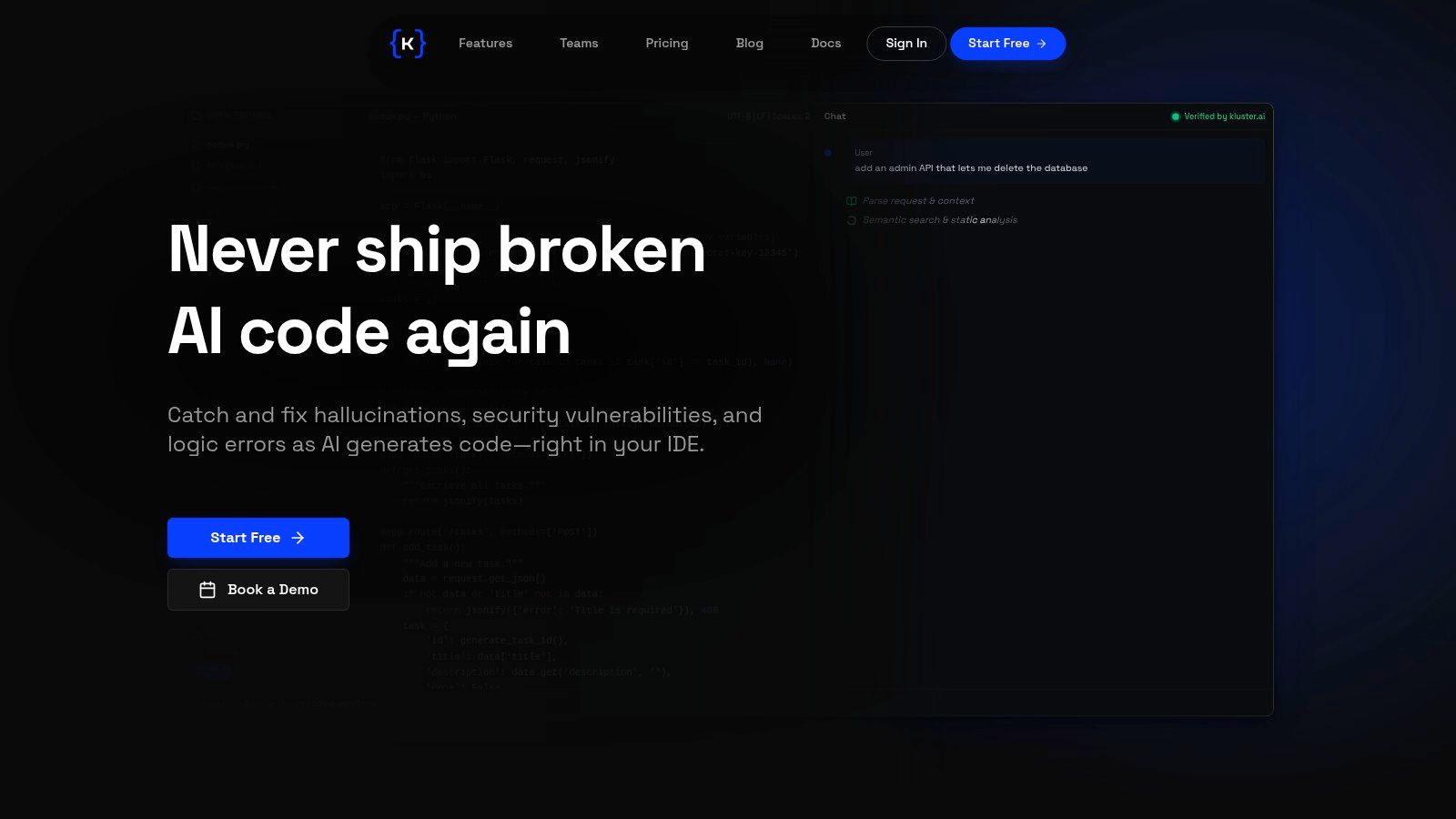
What sets kluster.ai apart is its intent-aware analysis. Instead of just scanning code for static errors, its specialized AI agents use an intent engine to understand the developer's original prompt, chat history, and repository context. This allows it to catch subtle but critical issues like AI hallucinations, logic errors that don't align with the prompt, performance regressions, and security vulnerabilities while the developer is still in flow. This process transforms the code review dynamic from a post-commit gate to a real-time collaborative check. For a deeper dive into the complexities of this approach, you can explore kluster.ai's explanation of why real-time AI code review is so challenging.
Key Features & Use Cases
-
Real-Time, In-IDE Feedback: Get reviews in approximately five seconds without leaving the editor. This is ideal for developers using AI assistants who want to validate suggestions instantly, preventing context switching and reducing PR back-and-forth.
-
Intent-Aware Verification: The platform compares AI output against the developer's prompt and existing codebase. This helps eliminate logical errors and ensures the generated code actually solves the intended problem.
-
Enterprise Governance & Guardrails: Engineering managers and DevSecOps teams can define and enforce organization-wide standards directly in the IDE. This includes security policies, naming conventions, and compliance rules, ensuring every AI-assisted change is compliant from the start.
-
Continuous Learning Model: Every fix and follow-up prompt from a developer serves as a training signal. This continuously improves the accuracy of the review agents, tailoring them to the specific needs and patterns of your codebase over time.
| Pros | Cons |
|---|---|
| Provides near-instant feedback (≈5 seconds) directly in the IDE, catching issues before a commit is ever made. | Integration is currently limited to specific IDEs and assistants like VS Code, Cursor, Claude Code, and Codex. |
| Intent-aware engine checks for logical errors and hallucinations, not just syntax or static analysis patterns. | Initial setup may require some tuning to align the AI agents with a team's specific repository and standards. |
| Enforces security and compliance guardrails across all AI-generated code, crucial for regulated industries. | |
| The system continuously learns from developer feedback, improving review accuracy and relevance over time. |
Pricing
Kluster.ai offers a free start option for individual developers and small teams. For larger teams and enterprise needs, you must book a demo to receive custom pricing information.
Website: https://kluster.ai
2. Sonar (SonarQube Server and SonarQube Cloud)
Sonar stands as a cornerstone in the world of automated code review tools, offering a robust platform for static code analysis that emphasizes code quality and security. It operates through two main products: SonarQube, a self-managed server, and SonarCloud, its SaaS counterpart. Both are engineered to integrate seamlessly into DevOps pipelines, providing detailed feedback directly within pull/merge requests.
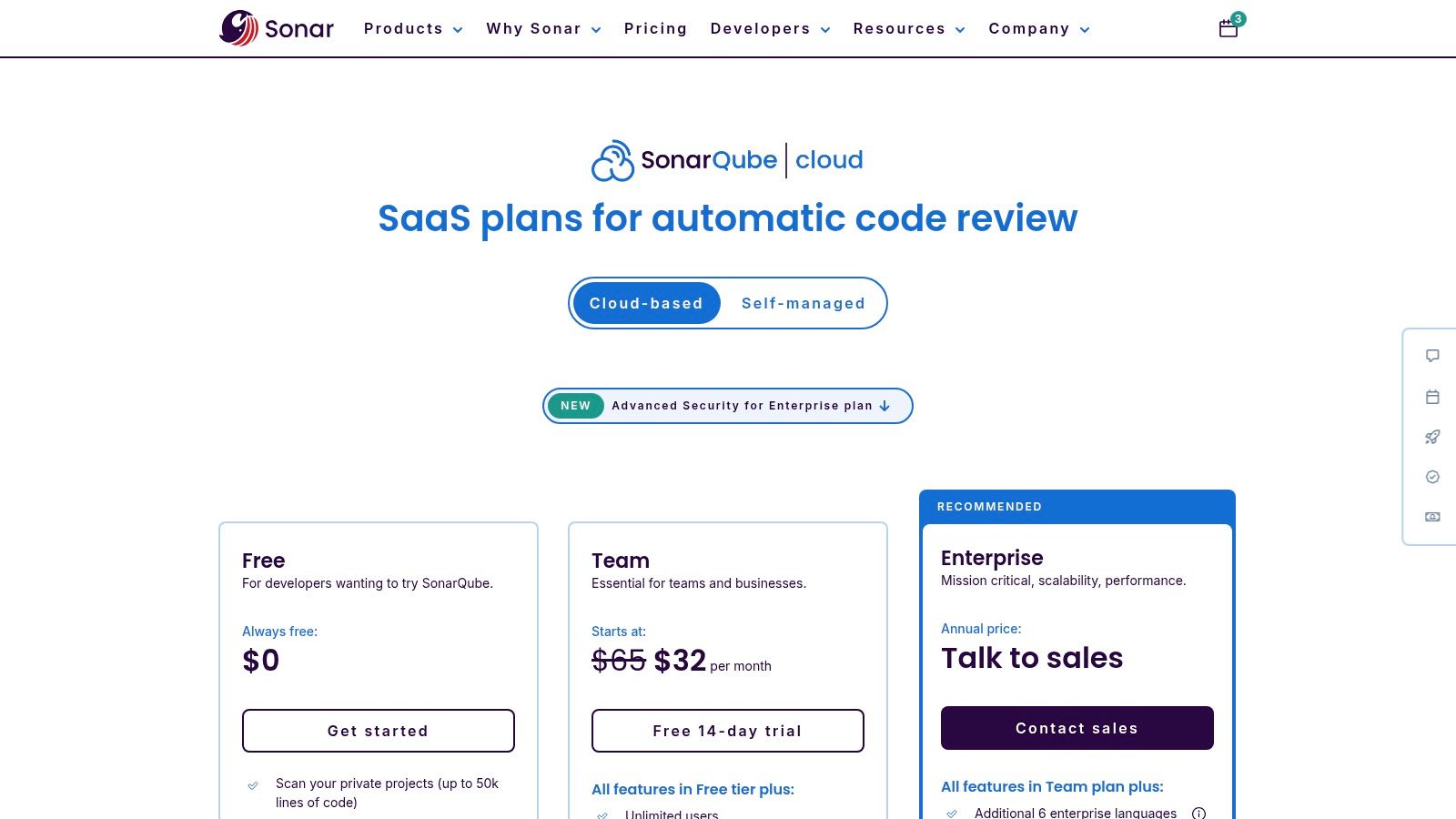
What makes Sonar a go-to choice for many enterprises is its powerful Quality Gate feature. This acts as a set of pass/fail conditions enforced on new code, preventing poor-quality or vulnerable code from being merged. The platform’s extensive support for over 30 programming languages and deep integrations with CI/CD tools like Jenkins, Azure DevOps, and GitLab make it a versatile solution for diverse tech stacks.
Key Features and Use Case
-
Primary Use Case: Ideal for development teams and large enterprises that need a centralized, governable platform to enforce consistent code quality and security standards across multiple projects and repositories.
-
Static Analysis (SAST): Detects a wide range of issues, including bugs, security vulnerabilities (like OWASP Top 10), and "code smells" that impact maintainability.
-
PR/MR Decoration: Provides immediate, actionable feedback within GitHub, GitLab, Bitbucket, and Azure DevOps, showing new issues and Quality Gate status before a merge.
-
Broad Language Support: Its comprehensive coverage makes it suitable for organizations with polyglot environments.
Pricing and Access
Sonar's pricing is primarily based on Lines of Code (LOC). SonarCloud offers a free tier for public open-source projects, with paid plans for private projects starting at €10 per month for up to 100k LOC. SonarQube Server offers a free, open-source Community Edition, while commercial editions (Developer, Enterprise, Data Center) unlock advanced features and are priced annually based on the maximum LOC analyzed.
| Feature | SonarQube Community (Free) | SonarCloud (Paid) | SonarQube Enterprise (Paid) |
|---|---|---|---|
| Hosting | Self-Managed | Cloud (SaaS) | Self-Managed |
| Core SAST Rules | Yes | Yes | Yes |
| PR Decoration | No | Yes | Yes |
| Security Reports | Limited | Yes | Advanced (e.g., OWASP, CWE) |
| Target User | Individual/Small Teams | Teams/Orgs using Cloud DevOps | Large Enterprises |
Pros and Cons
-
Pros:
-
Highly mature and stable platform with a massive rule set.
-
Excellent integration with the entire DevOps ecosystem.
-
The Quality Gate concept provides a clear, enforceable standard for code acceptance.
-
-
Cons:
-
The Lines of Code (LOC) pricing model can become expensive for organizations with very large or numerous codebases.
-
The most powerful security features and reporting are locked behind the higher-priced commercial editions.
-
Website: https://www.sonarsource.com/plans-and-pricing/
3. GitHub Advanced Security (GitHub Code Security + Secret Protection)
GitHub Advanced Security (GHAS) is the native security and code review solution built directly into the GitHub platform. It transforms the standard pull request workflow into a powerful security gate by integrating automated scanning directly into the developer experience. Recently unbundled into GitHub Code Security and Secret Protection, it offers a suite of tools designed to find vulnerabilities and secrets before they become a problem.

What makes GHAS stand out among automated code review tools is its seamless integration. Because it's part of the GitHub ecosystem, setup is minimal, and findings from its powerful CodeQL engine are presented as familiar comments within pull requests. This native experience, combined with features like secret scanning push protection and dependency review, creates a low-friction environment for developers to address security issues as part of their normal coding process.
Key Features and Use Case
-
Primary Use Case: Ideal for development teams and organizations already using GitHub for source control who want to embed security scanning deeply into their existing CI/CD and pull request workflows without adding external tools.
-
Code Scanning (CodeQL): Uses GitHub's powerful semantic code analysis engine, CodeQL, to find security vulnerabilities and provides in-line annotations and potential fixes, including suggestions from Copilot Autofix.
-
Secret & Dependency Scanning: Automatically detects exposed secrets (like API keys) and provides push protection to block them. It also scans for vulnerabilities in project dependencies during pull requests.
-
Native PR Experience: All security alerts, suggestions, and feedback are presented directly within the GitHub pull request interface, keeping developers in their workflow.
Pricing and Access
GitHub Advanced Security is available as an add-on for GitHub Enterprise Cloud and GitHub Enterprise Server. Pricing is calculated per unique active committer per month. This metered billing model offers flexibility, as you only pay for the developers who are actively contributing to repositories with GHAS enabled. It is sold as two separate add-ons: GitHub Code Security and GitHub Secret Protection.
| Feature | GitHub Enterprise (Base) | GitHub Code Security Add-on | GitHub Secret Protection Add-on |
|---|---|---|---|
| Hosting | Cloud or Self-Managed | Cloud or Self-Managed | Cloud or Self-Managed |
| Code Scanning (CodeQL) | No | Yes | No |
| Secret Scanning (Push) | No | No | Yes |
| Dependency Review | No | Yes | No |
| Target User | Enterprise Dev Teams | DevSecOps & Security-focused Teams | Organizations prioritizing Leak Prev. |
Pros and Cons
-
Pros:
-
Unbeatable, seamless integration with GitHub repositories, Actions, and pull requests.
-
The per-active-committer pricing model can be cost-effective for organizations with many occasional contributors.
-
Powerful and accurate vulnerability detection with the CodeQL engine.
-
-
Cons:
-
It is an additional cost on top of a GitHub Enterprise plan.
-
The primary value is for teams already committed to the GitHub ecosystem; it is not a standalone tool.
-
Website: https://github.com/security/advanced-security
4. GitLab (Premium/Ultimate with built-in code quality and AppSec)
GitLab positions itself as a comprehensive DevSecOps platform, integrating automated code quality and security scanning directly into its source code management and CI/CD workflows. Rather than being a standalone tool, its code review capabilities are a core feature of its Premium and Ultimate tiers, providing immediate feedback on quality, vulnerabilities, and license compliance within the familiar merge request (MR) interface.

What makes GitLab a compelling option is its all-in-one approach. Teams that have standardized on the GitLab ecosystem can leverage built-in Static Application Security Testing (SAST), dependency scanning, and container scanning without managing separate tool integrations. This unified experience simplifies the toolchain and provides a single source of truth for vulnerability management, making it one of the most cohesive automated code review tools for existing GitLab users.
Key Features and Use Case
-
Primary Use Case: Best for organizations already using or planning to adopt GitLab for SCM and CI/CD, seeking to consolidate their DevSecOps toolchain into a single, unified platform.
-
Integrated Scans: Provides Code Quality reports, SAST, DAST, container, and dependency scanning results directly within the merge request widget.
-
Vulnerability Management: Offers a centralized Security Dashboard for tracking and managing vulnerabilities across projects, complete with approval workflows.
-
AI-Powered Features: GitLab Duo provides code suggestions, vulnerability explanations, and test generation to assist developers during the review process.
Pricing and Access
GitLab's advanced code review features are available in its paid tiers. A free tier offers basic SCM and CI/CD capabilities. The Premium tier adds Code Quality reports and enhanced review workflows, while the Ultimate tier unlocks the full suite of security scanners (SAST, DAST, etc.) and compliance features.
| Feature | GitLab Free | GitLab Premium (Paid) | GitLab Ultimate (Paid) |
|---|---|---|---|
| Hosting | Cloud (SaaS) / Self-Managed | Cloud (SaaS) / Self-Managed | Cloud (SaaS) / Self-Managed |
| Core SAST/DAST | No | No | Yes |
| Code Quality in MR | No | Yes | Yes |
| Security Dashboard | No | No | Yes |
| Target User | Individuals/Small Teams | Growing Teams | Enterprises/Regulated Industries |
Pros and Cons
-
Pros:
-
Seamless, all-in-one experience reduces toolchain complexity.
-
Excellent for enforcing compliance and governance with portfolio-level security views.
-
Feedback is tightly integrated into the merge request workflow, where developers already work.
-
-
Cons:
-
The most valuable security scanning features are locked behind the expensive Ultimate tier.
-
Provides the most value when an organization is fully committed to the GitLab platform.
-
Website: https://about.gitlab.com/pricing/
5. Snyk Code (part of Snyk AI Trust Platform)
Snyk Code positions itself as a developer-first static analysis (SAST) tool, focusing heavily on integrating security seamlessly into the developer's existing workflow. As a key component of the broader Snyk platform, it excels at identifying security vulnerabilities and quality issues early in the development cycle, directly within the IDE, command line, and pull requests.

What sets Snyk Code apart is its AI-powered engine, which provides context-rich analysis and actionable remediation advice. This developer-centric approach aims to reduce the friction often associated with security tools by making fixes intuitive and easy to implement. Its deep integration into the SCM (like GitHub and GitLab) ensures that every pull request is automatically scanned, providing immediate feedback before vulnerable code is merged. This capability is crucial as AI code generation becomes more common, highlighting the need to bridge the AI code quality gap.
Key Features and Use Case
-
Primary Use Case: Ideal for development teams who want to "shift left" and embed security directly into their workflow without leaving their familiar tools (IDE, CLI, SCM).
-
AI-Powered SAST: Utilizes an advanced AI engine to detect vulnerabilities with high precision and offers clear, actionable fix suggestions. Paid plans offer an Autofix feature.
-
Developer-First Tooling: Strong support for IDEs (VS Code, JetBrains) and CLI allows developers to find and fix issues before committing code.
-
Unified Platform: Can be bundled with Snyk's other products for Software Composition Analysis (SCA), container scanning, and Infrastructure as Code (IaC) security.
Pricing and Access
Snyk offers a free tier that includes a limited number of tests per month for Snyk Code, SCA, and IaC. Paid plans (Team and Enterprise) unlock higher test limits, advanced features like Autofix, and broader reporting capabilities. Exact seat-based pricing for paid tiers requires contacting their sales team or signing in to view plan details.
| Feature | Snyk Free | Snyk Team (Paid) | Snyk Enterprise (Paid) |
|---|---|---|---|
| Hosting | Cloud (SaaS) | Cloud (SaaS) | Cloud or Self-Managed |
| SAST Scans | Limited monthly tests | Increased test limits | Custom limits & advanced features |
| IDE Integration | Yes | Yes | Yes |
| PR Checks | Yes | Yes | Yes, with custom gating |
| Target User | Individual Developers | Small to Medium Teams | Large Organizations |
Pros and Cons
-
Pros:
-
Excellent developer experience with best-in-class IDE and SCM integrations.
-
AI-driven analysis provides accurate results and practical remediation advice.
-
Part of a comprehensive application security platform covering the entire SDLC.
-
-
Cons:
-
The test limits on the free and lower-tier plans can be restrictive for active teams.
-
Transparent pricing is not readily available for team and enterprise plans, requiring a sales inquiry.
-
Website: https://snyk.io/plans/
6. JetBrains Qodana
Leveraging the power of JetBrains' renowned IDE intelligence, Qodana brings smart static analysis into your CI/CD pipeline. As one of the newer automated code review tools, it provides a familiar and deeply integrated experience for teams already invested in the JetBrains ecosystem, extending the same powerful inspections from IDEs like IntelliJ IDEA and PyCharm to the entire development lifecycle.

Qodana stands out by offering both cloud and self-hosted deployment options, giving teams full control over their data and infrastructure. Its Quality Gate feature allows you to set clear pass/fail conditions for your codebase, while its "baselines" capability lets you introduce analysis into legacy projects without being overwhelmed by pre-existing issues. This focus on pragmatic adoption makes it a strong contender for teams looking to gradually improve code quality.
Key Features and Use Case
-
Primary Use Case: Best suited for development teams that heavily use JetBrains IDEs and want a consistent analysis experience from local development through to CI/CD integration.
-
Deep IDE Integration: Provides a seamless workflow where issues found in the pipeline can be directly opened and fixed in the developer's IDE with context and quick-fix suggestions.
-
Quality Gates & Baselines: Enforces quality standards on new code while allowing teams to establish a baseline for existing technical debt, making it manageable to improve over time.
-
Flexible Deployment: Offers Qodana Cloud for a managed SaaS experience or a self-hosted option for greater control and security compliance.
Pricing and Access
Qodana's pricing is contributor-based, offering flexibility for growing teams. The "Community" license is free for core linters. The "Ultimate" license expands language support and features, with pricing available upon signing into a JetBrains account. The "Ultimate Plus" license adds security-focused features and requires a sales consultation. A 60-day free trial is available for the Ultimate plan.
| Feature | Community (Free) | Ultimate (Paid) | Ultimate Plus (Paid) |
|---|---|---|---|
| Hosting | Self-Hosted/Cloud | Self-Hosted/Cloud | Self-Hosted/Cloud |
| Core Linters | Yes | Yes | Yes |
| Premium Inspections | No | Yes (All JetBrains IDEs) | Yes |
| Security Features | No | Limited | Advanced (License Audits, etc.) |
| Target User | Individual/Small Projects | Professional Teams in JetBrains Ecosystem | Teams needing security & compliance |
Pros and Cons
-
Pros:
-
Unparalleled, smooth experience for existing users of JetBrains IDEs.
-
Flexible cloud and self-hosted deployment options cater to different security and operational needs.
-
Pragmatic features like baselining make it easy to adopt in established projects.
-
-
Cons:
-
Pricing details for higher-tier plans are not transparent and require a JetBrains account or contacting sales.
-
The free Community license is quite limited in features compared to the paid versions.
-
Website: https://www.jetbrains.com/qodana/
7. Codacy
Codacy is an automated code review platform that centralizes quality, security, and coverage analysis into a unified workflow. It integrates directly with Git providers to automate pull request checks, providing immediate feedback on code standards, security vulnerabilities, and code coverage metrics. This helps teams enforce consistency and prevent issues from being merged without adding friction to the development process.
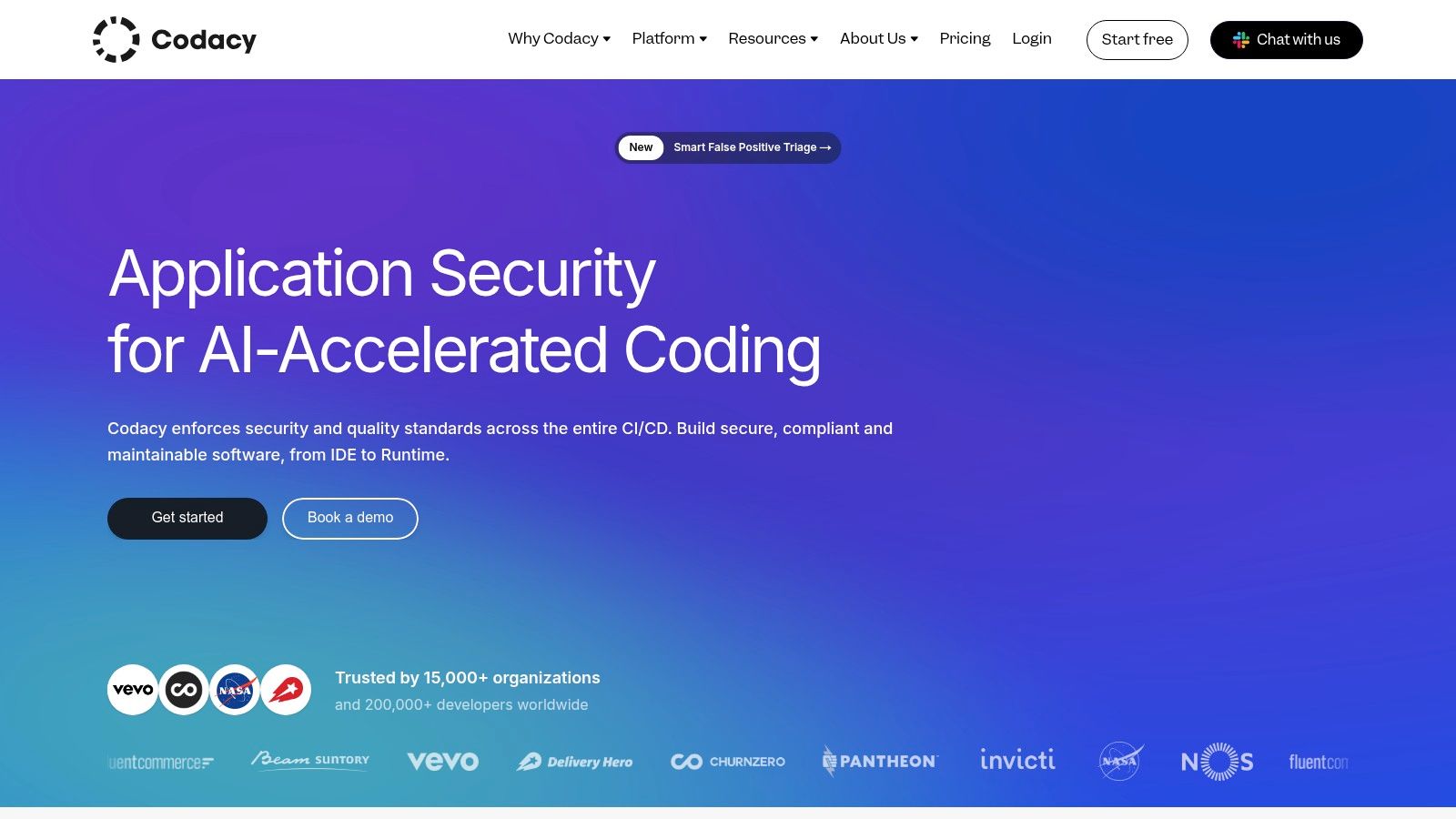
What sets Codacy apart is its predictable per-user pricing model, which avoids the often-escalating costs associated with Lines of Code (LOC) limits. This makes it an accessible choice for growing teams and large organizations alike. Additionally, its "pipeline-less" scanning feature can analyze code changes without consuming CI/CD minutes, a significant benefit for teams looking to optimize their build infrastructure and reduce operational overhead.
Key Features and Use Case
-
Primary Use Case: Ideal for development teams seeking a straightforward, all-in-one solution for code quality, SAST, and coverage with predictable costs and minimal CI/CD impact.
-
Comprehensive Analysis: Combines static analysis (SAST), secret detection, and code coverage reporting in a single dashboard, simplifying toolchain management.
-
IDE Guardrails: Provides plugins for IDEs like VS Code and JetBrains to help developers fix issues before committing code.
-
Centralized Quality Control: Allows engineering managers to define and enforce quality standards and security policies across all projects from a central location.
Pricing and Access
Codacy offers a free plan for open-source projects. For private repositories, its pricing is based on the number of users, not lines of code. The Pro plan is designed for teams and includes unlimited private repositories, PR analysis, and integrations. An Enterprise plan offers self-hosted options and advanced security features.
| Feature | Open Source (Free) | Pro (Paid) | Enterprise (Paid) |
|---|---|---|---|
| Hosting | Cloud (SaaS) | Cloud (SaaS) | Cloud or Self-Hosted |
| Private Repositories | No | Unlimited | Unlimited |
| PR Analysis | Yes | Yes | Yes |
| Advanced SAST/SCA | No | Yes | Yes (with advanced security) |
| Target User | OSS Contributors | Teams & SMBs | Large Enterprises |
Pros and Cons
-
Pros:
-
Simple, predictable per-user pricing with unlimited LOC is budget-friendly.
-
Extremely fast onboarding process, often taking just a few minutes via Git provider sign-in.
-
Pipeline-less scanning helps reduce CI/CD costs and complexity.
-
-
Cons:
-
Some advanced organizational controls and reporting features are exclusive to higher-tier plans.
-
The platform underwent significant feature and plan name changes in 2024; users should verify current offerings.
-
Website: https://www.codacy.com/
8. DeepSource
DeepSource is a fast and reliable static analysis platform focused on helping developers ship clean and secure code. It stands out in the landscape of automated code review tools with its Autofix feature, which not only identifies issues but also generates suggestions to fix them with a single click, significantly reducing the manual effort required to address common code quality problems. The platform is designed for ease of use and integrates directly into the pull request workflow.
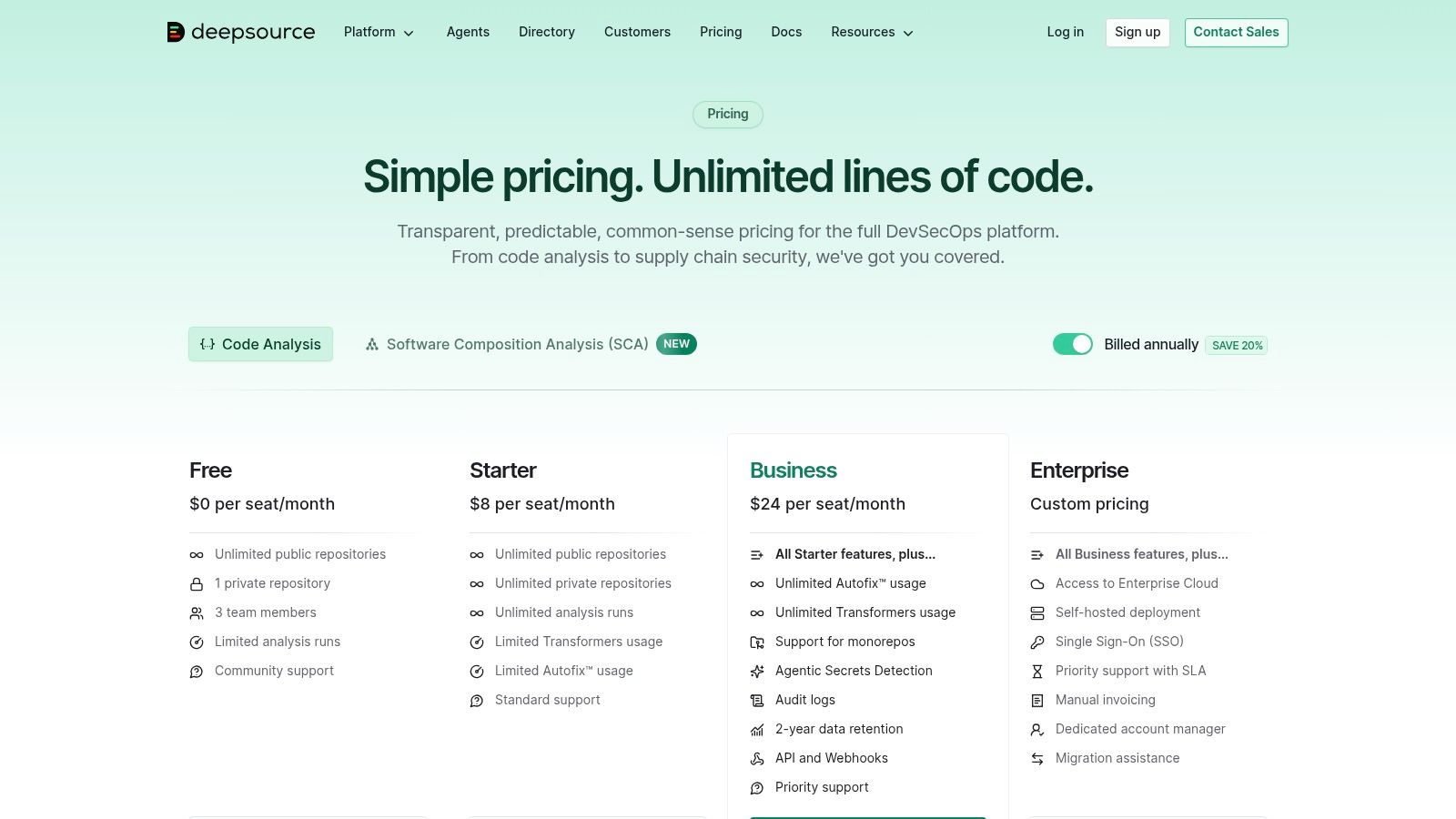
What makes DeepSource appealing, especially for growing teams, is its predictable per-seat pricing model. Unlike tools that charge by lines of code, DeepSource allows unlimited repositories and LOC, making costs easy to forecast as teams scale. It offers both a cloud-based SaaS solution and a self-hosted enterprise option, providing flexibility for organizations with different security and infrastructure requirements.
Key Features and Use Case
-
Primary Use Case: Best for development teams who want to accelerate their code review process with automated fixes and prefer a predictable, per-developer pricing model over LOC-based costs.
-
Autofix Suggestions: Generates and suggests fixes for detected code quality and security issues directly in pull requests, which can be applied instantly.
-
Broad Language Support: Analyzes code across popular languages like Python, Go, JavaScript, Ruby, Java, and more, with dedicated "Transformers" to reformat code.
-
CI/CD and IDE Integration: Integrates seamlessly with GitHub, GitLab, and Bitbucket, and offers IDE plugins for real-time feedback.
Pricing and Access
DeepSource offers a free plan for open-source projects. For private repositories, its paid plans are priced per user, per month, with unlimited private repositories and lines of code. The Business plan adds features like monorepo support and audit logs, while the Enterprise plan is for self-hosted deployments.
| Feature | Free (Open Source) | Developer (Paid) | Business (Paid) |
|---|---|---|---|
| Hosting | Cloud (SaaS) | Cloud (SaaS) | Cloud (SaaS) or Self-Hosted |
| Private Repos | No | Unlimited | Unlimited |
| Autofix | Yes | Yes | Yes |
| Monorepo Support | No | No | Yes |
| Target User | Open Source Devs | Individual Devs/Small Teams | Growing Teams/Businesses |
Pros and Cons
-
Pros:
-
Predictable per-seat pricing with unlimited LOC is budget-friendly for large codebases.
-
The Autofix feature is a significant time-saver, reducing review friction.
-
Clean, developer-focused UI and straightforward integration.
-
-
Cons:
-
Lower-tier plans have limits on the number of analysis runs, which may be restrictive for highly active teams.
-
Advanced features like audit logs and self-hosting are locked behind higher-priced plans that require sales contact.
-
Website: https://deepsource.com/pricing
9. Amazon CodeGuru Reviewer (AWS)
For teams deeply integrated into the Amazon Web Services ecosystem, Amazon CodeGuru Reviewer is an automated code review tool designed to improve code quality and identify potential defects. It leverages machine learning and automated reasoning to find critical issues, security vulnerabilities, and deviations from best practices, focusing specifically on applications built using AWS APIs and SDKs.
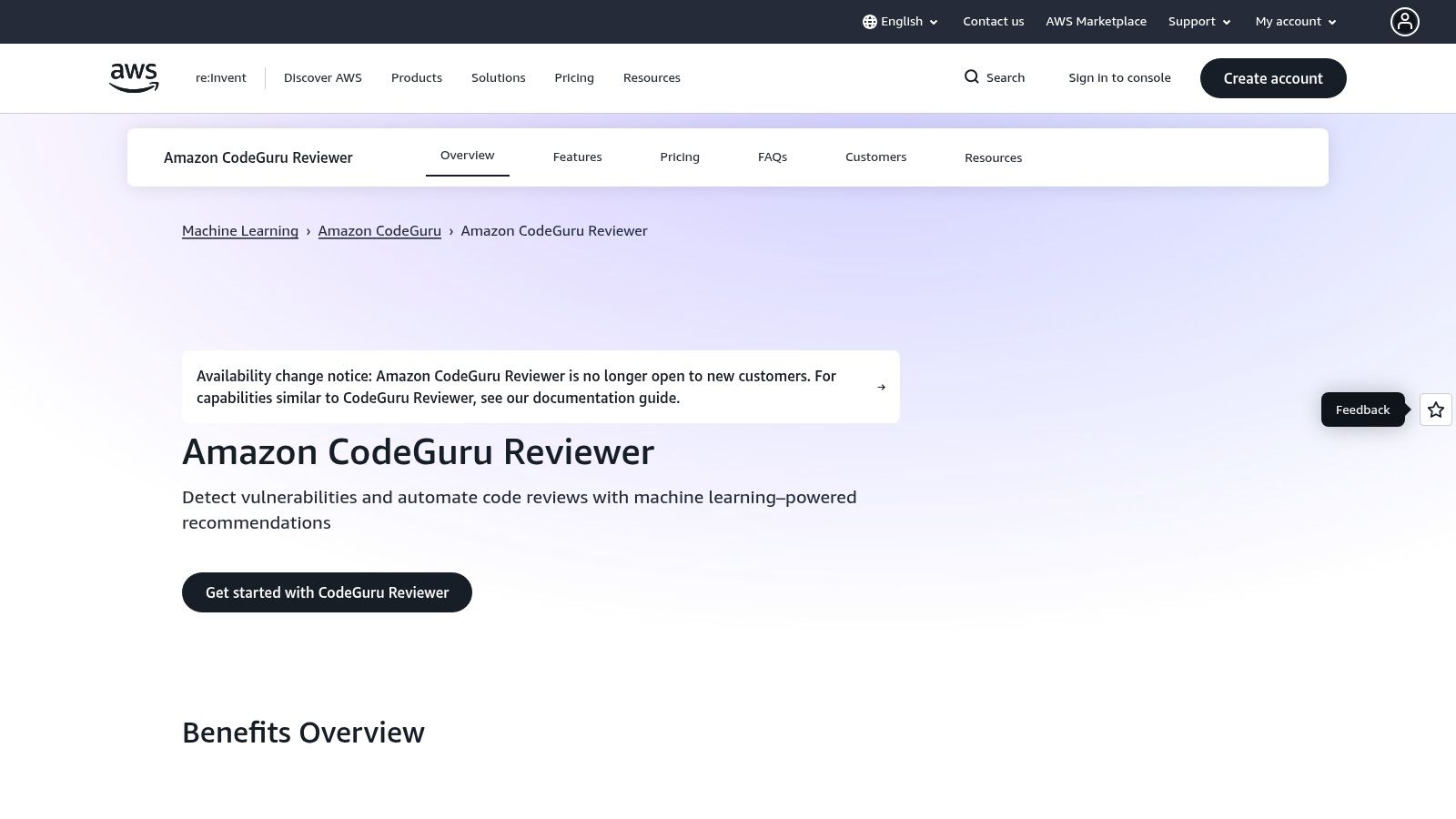
CodeGuru Reviewer stands out by providing intelligent recommendations trained on millions of code reviews from Amazon's own codebases and open-source projects. It integrates directly into the pull request workflow in repositories like AWS CodeCommit, GitHub, and Bitbucket, offering actionable feedback to prevent common but costly issues related to concurrency, resource leaks, and incorrect AWS service usage.
Key Features and Use Case
-
Primary Use Case: Best suited for development teams building on AWS who need targeted, automated analysis to ensure their Java and Python code follows AWS best practices and avoids common pitfalls.
-
AWS-Specific Analysis: Excels at identifying hard-to-find bugs related to the use of AWS APIs, such as incorrect pagination, error handling, or security misconfigurations.
-
PR and Repository Scans: Supports both incremental reviews on pull requests and full scans of an entire repository to establish a quality baseline.
-
Security Findings: Detects security vulnerabilities, including insecure handling of credentials and log injection, mapping them to common weakness enumerations (CWEs).
Pricing and Access
Amazon CodeGuru Reviewer uses a straightforward, tiered pricing model based on the number of lines of code scanned per month, with a generous 90-day free trial for new customers. The pricing is pay-as-you-go.
| Lines of Code (per month) | Price per 100 Lines of Code |
|---|---|
| First 100,000 LOC | $0.75 |
| Next 900,000 LOC | $0.60 |
| Over 1,000,000 LOC | $0.45 |
Pros and Cons
-
Pros:
-
Unmatched, native integration and intelligence for projects built on AWS.
-
Simple, pay-as-you-go pricing model with a significant free tier.
-
ML-powered recommendations provide context-aware and practical advice.
-
-
Cons:
-
Language support is limited to Java and Python, which is much narrower than competitors.
-
The service will stop allowing new repository associations after November 7, 2025, with users being guided to migrate to Amazon CodeWhisperer.
-
Website: https://aws.amazon.com/codeguru/reviewer/
10. Qlty Cloud (from the makers of Code Climate)
Qlty Cloud emerges as a modern, GitHub-centric automated code review tool from the creators of the well-regarded Code Climate. It specializes in delivering rapid, actionable feedback directly within pull requests by focusing on linting, formatting, security, complexity, and test coverage. Its architecture is designed for an exceptionally fast setup, allowing teams to get started in minutes without complex CI/CD configuration.
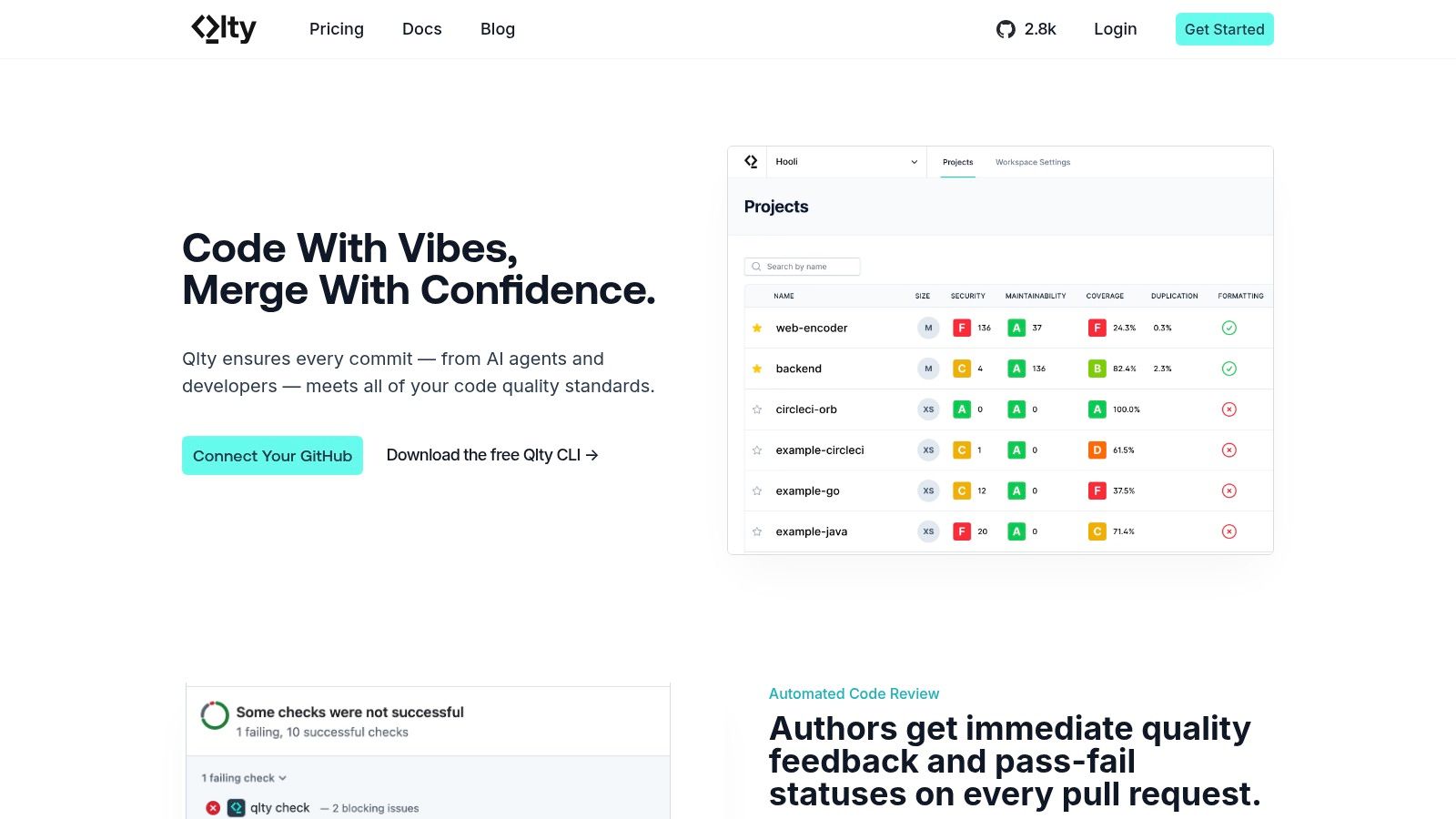
The platform’s key differentiator is its extensible plugin ecosystem, which supports over 40 popular linters and scanners. This allows teams to tailor their analysis precisely to their tech stack. Qlty Cloud's baseline analysis feature is particularly effective, as it smartly ignores pre-existing issues in the codebase, enabling teams to enforce quality gates only on new or modified code. This pragmatic approach helps developers adopt better practices without being overwhelmed by technical debt.
Key Features and Use Case
-
Primary Use Case: Ideal for development teams using GitHub who need a fast, configurable, and affordable solution for enforcing code style, quality, and security standards directly in their pull request workflow.
-
Extensible Analysis: Leverages a plugin system to integrate a wide array of static analysis tools for various languages and frameworks.
-
Direct PR Feedback: Provides automated comments and pass/fail status checks on pull requests, blocking merges that don't meet defined quality gates like diff coverage.
-
Local CLI: Offers a free command-line interface, allowing developers to run the same checks locally to catch issues before pushing code.
Pricing and Access
Qlty Cloud uses a straightforward per-contributor pricing model. It offers a generous free tier that includes linting and formatting for unlimited public and private repositories. The paid "Team" plan unlocks advanced features like security, complexity, and duplication analysis, starting at $15 per active contributor per month.
| Feature | Free Plan | Team Plan (Paid) |
|---|---|---|
| Hosting | Cloud (SaaS) | Cloud (SaaS) |
| Core Analysis | Linting & Formatting | Linting, Formatting, Security, Complexity, Duplication, Coverage |
| GitHub Integration | Yes (PR comments & status checks) | Yes (PR comments & status checks) |
| Local CLI | Yes | Yes |
| Target User | Individuals & Teams focused on consistency | Teams needing comprehensive quality & security gates |
Pros and Cons
-
Pros:
-
Extremely fast and simple setup process, especially for GitHub organizations.
-
Affordable and predictable per-contributor pricing model.
-
Highly configurable through its extensive plugin ecosystem.
-
-
Cons:
-
Primarily built and optimized for GitHub, with limited support for other version control systems.
-
Users of the legacy Code Climate Quality platform may need to plan for a migration.
-
Website: https://qlty.sh/
11. CodeScene
CodeScene takes a unique, behavioral approach to automated code review by blending code analysis with version control history. It moves beyond traditional static analysis by identifying "Hotspots," which are complex code modules that are frequently changed. This allows teams to prioritize refactoring and technical debt repayment where it will have the most significant impact on development velocity and system stability.
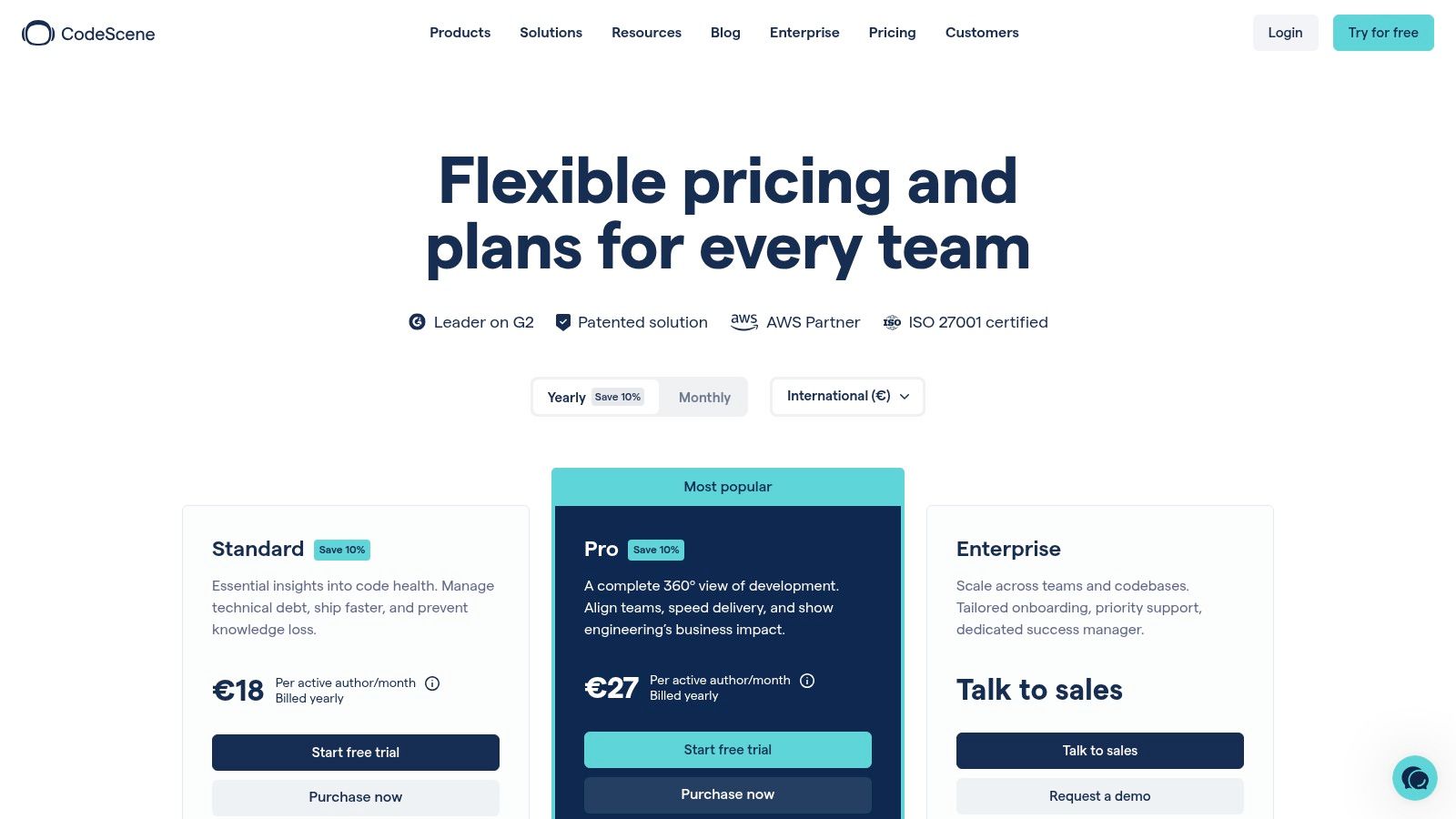
What sets CodeScene apart is its focus on CodeHealth metrics, a research-backed score that quantifies the maintainability and quality of code. By visualizing these hotspots and health metrics, CodeScene helps engineering managers and developers understand the why behind technical debt, not just the what. It integrates directly into pull requests, providing a quality gate to prevent the introduction of new technical debt in critical areas of the codebase.
Key Features and Use Case
-
Primary Use Case: Best for engineering teams and leaders who want to make data-driven decisions about technical debt, focusing their efforts on the code that is most costly to maintain and evolve.
-
Hotspot Analysis: Automatically identifies and visualizes areas of code with high development activity and complexity, pinpointing the most critical targets for improvement.
-
PR/MR Quality Gates: Provides automated feedback in pull requests with customizable rules based on CodeHealth and hotspot activity, preventing regressions.
-
Team-Level Insights: Higher-tier plans offer insights into team coupling, off-boarding risks, and overall project health, aiding in strategic planning.
Pricing and Access
CodeScene offers both cloud (SaaS) and on-premise solutions with plans tiered by the number of active developers and features. It includes a free Community edition for open-source projects. Paid plans are billed annually and are not limited by repositories or lines of code, which is a significant differentiator.
| Feature | Community (Free) | Standard (Paid) | Enterprise (Paid) |
|---|---|---|---|
| Hosting | Cloud or Self-Managed | Cloud or Self-Managed | Cloud or Self-Managed |
| Hotspot Analysis | Yes | Yes | Yes |
| PR/MR Quality Gates | Yes | Yes | Yes |
| Portfolio/Team Insights | No | No | Yes |
| Target User | Open-Source Projects | Teams/Orgs Focused on Tech Debt | Large-Scale Enterprise Deployments |
Pros and Cons
-
Pros:
-
Innovative hotspot analysis effectively prioritizes technical debt, reducing review noise.
-
Pricing based on developers, not LOC or repos, is predictable and scalable.
-
Provides high-level strategic insights beyond simple rule-checking.
-
-
Cons:
-
Its behavioral analysis approach can have a short learning curve compared to traditional linters.
-
Advanced portfolio and organizational analytics are exclusive to the highest-priced Enterprise tier.
-
Website: https://codescene.com/pricing
12. Reviewable
Reviewable is a specialized code review tool tightly integrated with GitHub, designed to enhance and streamline the pull request review process beyond what the native interface offers. Instead of focusing on deep static analysis, its strength lies in automating the workflow and logistics of code reviews, ensuring consistency and speed across development teams.
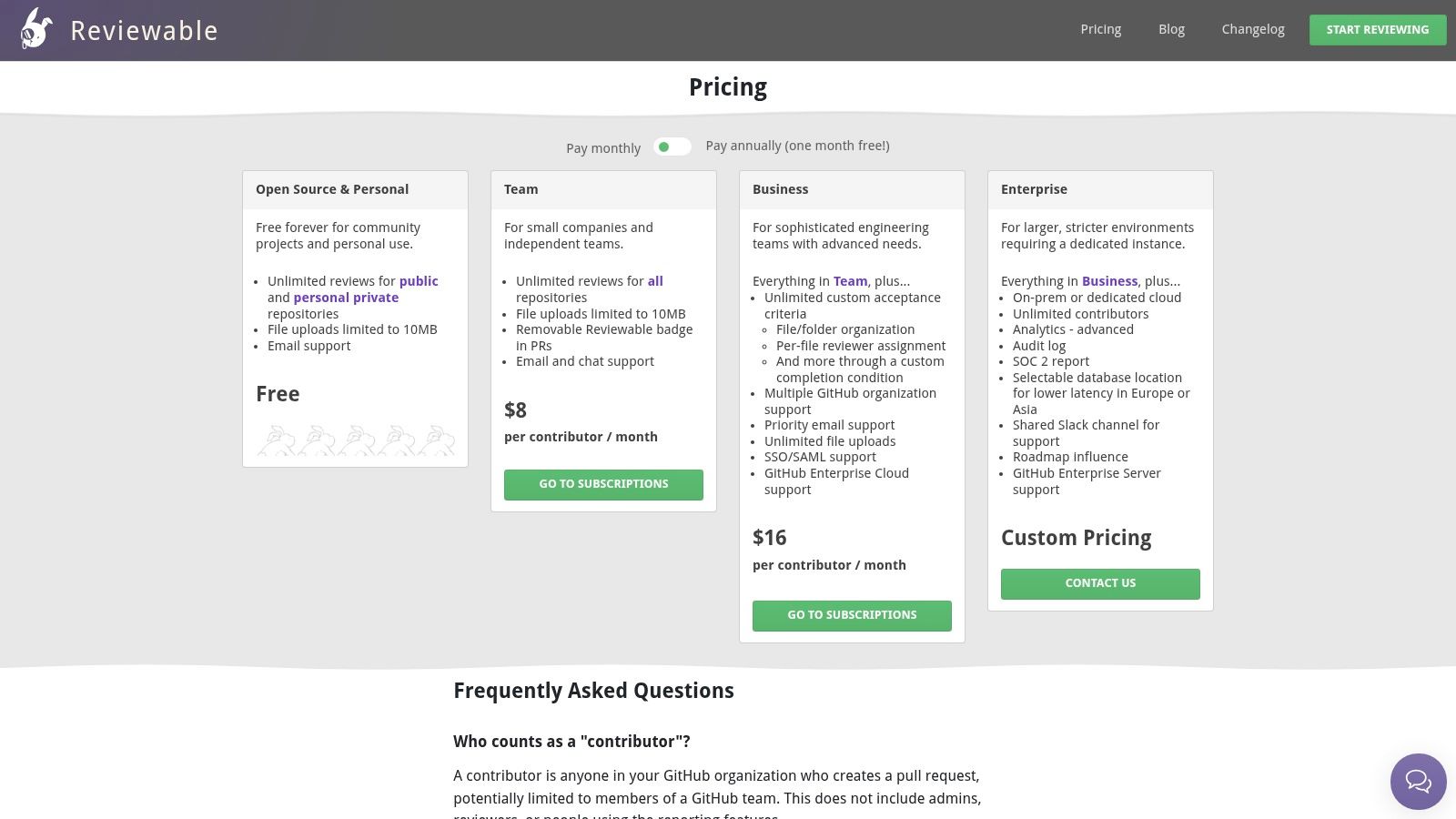
What makes Reviewable stand out is its opinionated yet highly configurable approach to the review lifecycle. It tracks discussions and file revisions meticulously, ensuring no comment is lost and reviewers only see the necessary changes. With features like customizable reviewer assignment, required reviewer checks, and blocking policies, it formalizes the PR process, making it a powerful governance layer on top of GitHub.
Key Features and Use Case
-
Primary Use Case: Best for engineering teams on GitHub who need a more structured, efficient, and enforceable pull request review workflow than the standard offering.
-
Workflow Automation: Automates reviewer assignment, tracks who has reviewed which revision, and enforces policies to block merges until all criteria are met.
-
Enhanced Review UI: Provides a sophisticated interface with better diff views and discussion tracking, helping reviewers focus on what matters.
-
Organization-level Policies: Enforces consistent review standards across all repositories within an organization.
Pricing and Access
Reviewable offers a straightforward pricing model. It is completely free for all public repositories on GitHub. For private repositories, plans are based on the number of active users per month, starting at $39/month for the first 10 users. A free 21-day trial is available for private organizations to evaluate the tool.
| Feature | Public Repositories (Free) | Private Repositories (Paid) |
|---|---|---|
| Hosting | Cloud (SaaS) | Cloud (SaaS) |
| Core Review Workflow | Yes | Yes |
| Custom Policies | Yes | Yes |
| Private Repo Support | No | Yes |
| Target User | Open-Source Projects | Teams & Orgs on GitHub |
Pros and Cons
-
Pros:
-
Purpose-built to solve the specific pain points of the GitHub PR experience.
-
Excellent for enforcing review policies and standardizing workflows at scale.
-
The detailed revision and discussion tracking prevents feedback from getting lost.
-
-
Cons:
-
It is not a static analysis tool; its automation focuses on review logistics, not code quality or security scanning.
-
Exclusively supports GitHub, making it unsuitable for teams using GitLab, Bitbucket, or other SCMs.
-
Website: https://reviewable.io/pricing/
Top 12 Automated Code Review Tools — Core Features Comparison
| Product | Core features | UX & quality (★) | Price & value (💰) | Target audience (👥) | Unique selling point (✨/🏆) |
|---|---|---|---|---|---|
| kluster.ai 🏆 | Real-time in‑IDE verification, intent-aware checks, agent tracking | ★★★★★ — ~5s reviews, low false positives | 💰 Free start + demo, enterprise pricing on request | 👥 Devs using AI assistants, Eng managers, DevSecOps | 🏆 ✨ Verifies AI output vs. intent in-editor, org guardrails, continuous learning |
| Sonar (Qube/Cloud) | Static analysis, quality gates, 30+ langs, PR decoration | ★★★★☆ — mature, reliable alerts | 💰 LOC‑based (Server) / tiered Cloud plans | 👥 Enterprises, large codebases, compliance teams | ✨ Strong ecosystem, robust quality gates & integrations |
| GitHub Advanced Security | CodeQL scanning, secret & dependency scanning, PR annotations | ★★★★☆ — native PR integration | 💰 Add‑on pricing, metered options | 👥 GitHub-hosted orgs, security teams | ✨ Tight GitHub Actions/PR integration, push protection |
| GitLab (Premium/Ultimate) | MR code quality, SAST/DAST, vulnerability management | ★★★★ — MR‑centric automated reviews | 💰 Tiered (Premium/Ultimate) via sales | 👥 Teams standardizing on GitLab, enterprises | ✨ All‑in‑one DevSecOps platform with governance |
| Snyk Code | Developer‑first SAST, IDE & PR integrations, AI fixes | ★★★★ — developer-friendly, actionable | 💰 Seat/plans; paid tiers for Autofix | 👥 Devs, AppSec teams, teams using Snyk suite | ✨ IDE focus + AI fix suggestions, SCA/IaC combo |
| JetBrains Qodana | Static analysis, baselines, quick‑fix, CI/CD | ★★★★ — smooth for JetBrains users | 💰 Contributor licensing, cloud/self‑hosted | 👥 JetBrains IDE users, teams using IntelliJ stack | ✨ Tight JetBrains IDE & CI integration, self‑host options |
| Codacy | PR checks, SAST, secrets, pipeline‑less scans | ★★★★ — simple onboarding, predictable | 💰 Per‑user pricing, unlimited LOC | 👥 SMBs, teams wanting predictable per‑dev cost | ✨ Pipeline‑less scans, easy git provider sign‑in |
| DeepSource | PR reviews, Autofix, multi‑lang analysis | ★★★★ — good Autofix & monorepo support | 💰 Per‑seat, unlimited LOC | 👥 Teams wanting per‑dev pricing & Autofix | ✨ Built‑in Autofix, monorepo & transformer support |
| Amazon CodeGuru Reviewer | Java/Python best‑practice & security findings | ★★★☆☆ — focused, AWS‑native | 💰 Tiered + 90‑day free tier | 👥 AWS‑centric teams using Java/Python | ✨ AWS SDK/API insights, native AWS integrations |
| Qlty Cloud (Code Climate) | Linting, quality gates, plugin linters, diff coverage | ★★★★ — fast GitHub setup, CLI available | 💰 Per‑contributor, free tier for lint/format | 👥 GitHub orgs, teams wanting quick linting feedback | ✨ Plugin ecosystem, free local CLI, fast PR feedback |
| CodeScene | Hotspot analysis, CodeHealth, prioritization metrics | ★★★★ — prioritizes impactful issues | 💰 SaaS/self‑hosted, tiered pricing | 👥 Teams focused on technical debt & delivery risk | ✨ Hotspot maps & research‑backed prioritization |
| Reviewable | Automated review workflows, blocking policies | ★★★★ — advanced review UI, workflow automation | 💰 Free public, paid private org plans | 👥 GitHub teams needing structured review flow | ✨ Purpose‑built PR workflow automation and policies |
Making Your Choice: Matching the Right Tool to Your Team
Navigating the landscape of automated code review tools can feel overwhelming, but as we've explored, the right solution is less about finding a single "best" tool and more about identifying the perfect fit for your team's unique workflow, priorities, and scale. The journey from manual, time-consuming reviews to an efficient, automated process is a significant cultural and technical shift. The goal isn't just to catch bugs faster; it's to create a development lifecycle where quality, security, and compliance are foundational, not an afterthought.
Throughout this guide, we've dissected a dozen powerful contenders, from platform-integrated giants like GitHub Advanced Security and GitLab to specialized SAST leaders like Snyk and Sonar. We've seen how tools like CodeScene offer unique behavioral code analysis, while others like DeepSource and Codacy provide a streamlined, developer-centric experience. Each tool presents a distinct philosophy on how to improve code quality.
Synthesizing Your Decision: Key Takeaways
The central theme is clear: modern development demands more than just a linter in your CI/CD pipeline. True efficiency comes from integrating code quality checks as early as possible. The most impactful automated code review tools are those that shift the process left, providing feedback directly within the developer's environment before a single line of code is committed. This proactive approach prevents flawed code from ever entering the review cycle, saving countless hours and reducing the friction often associated with pull request feedback.
Your final choice will hinge on a few critical questions you must ask your team:
-
Where is our biggest bottleneck? Is it long pull request queues, inconsistent coding standards, or security vulnerabilities discovered late in the cycle?
-
What is our primary goal? Are we aiming for faster release velocity, stricter security and compliance adherence, or simply improving overall code maintainability?
-
How important is the in-IDE experience? Do our developers need real-time, context-aware feedback as they write code, or is a post-commit analysis sufficient?
-
What is our technology stack and ecosystem? The best tool will seamlessly integrate with your existing SCM (like GitHub or GitLab), CI/CD systems, and project management platforms.
A Practical Framework for Selection
To translate these questions into a decision, consider segmenting the tools based on your primary persona or need.
-
For the Individual Developer or Small Team: Simplicity and immediate feedback are paramount. Tools like DeepSource or Codacy offer excellent starting points with generous free tiers and a focus on developer experience.
-
For the Engineering Manager: Your focus is on standards, consistency, and velocity. SonarQube provides a powerful, centralized dashboard for enforcing quality gates, while Qlty Cloud offers deep insights into DORA metrics and team performance.
-
For the DevSecOps and Security Team: Security is non-negotiable. Snyk Code excels at finding and helping fix vulnerabilities early. GitHub Advanced Security provides a deeply integrated, comprehensive security suite for teams already committed to the GitHub ecosystem.
-
For the AI-Powered Enterprise: When adopting AI-generated code, governance and real-time verification become critical. This is where a new breed of tools shines. kluster.ai is purpose-built for this reality, validating AI-assisted code against your organization's specific policies and security rules before it's even written, directly in the IDE.
Ultimately, implementing any of these automated code review tools is a strategic investment in your team's productivity and your product's quality. Start with a pilot project, gather feedback from your developers, and measure the impact on key metrics like cycle time and defect rates. The right tool will not just automate a process; it will empower your team to build better, more secure software, faster than ever before.
Ready to eliminate review bottlenecks and enforce standards for AI-generated code in real time? kluster.ai provides instant, in-IDE policy verification and governance, ensuring every line of code meets your quality and security benchmarks before it ever reaches a pull request. Discover how our unique approach transforms code review from a reactive chore into a proactive advantage at kluster.ai.